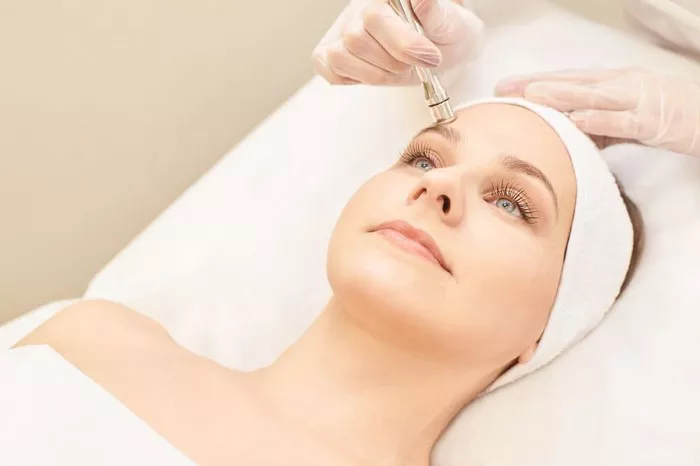Microdermabrasion is a non-invasive cosmetic procedure that uses a special device to exfoliate the top layer of the skin, revealing a smoother and more youthful appearance. This treatment is becoming increasingly popular because it is relatively affordable, requires no downtime, and can be performed on all skin types. In this article, we will explore what microdermabrasion before and after entails, including the benefits, risks, and what to expect during and after the procedure.
What is Microdermabrasion Before and After?
Microdermabrasion is a cosmetic procedure that uses a device with a diamond tip or a stream of fine crystals to remove the outermost layer of dead skin cells. This process stimulates the production of collagen and elastin, which are essential for healthy skin. The procedure is typically performed on the face, neck, chest, and hands, but can be done on other areas of the body as well.
Before the procedure, the skin is thoroughly cleansed and dried. The patient may be given protective eyewear to wear during the treatment. The device is then moved over the skin in a circular motion, gently exfoliating the top layer of dead skin cells. The procedure typically takes between 30 minutes to an hour, depending on the size of the treatment area.
After the procedure, the skin may be slightly pink and feel tight, but these effects typically subside within a few hours. The patient can resume their normal activities immediately after the procedure, but should avoid direct sun exposure and wear sunscreen to protect the treated area.
Benefits of Microdermabrasion Before and After
Microdermabrasion before and after has many benefits. The treatment can improve the appearance of fine lines and wrinkles, hyperpigmentation, acne scars, and other skin imperfections. It can also help to unclog pores and reduce the size of pores, resulting in a smoother and more even skin tone.
In addition to its cosmetic benefits, microdermabrasion can also improve the overall health and function of the skin. By removing the top layer of dead skin cells, the procedure stimulates the production of collagen and elastin, which are essential for healthy skin. This can help to improve the skin’s texture, tone, and elasticity, resulting in a more youthful appearance.
Microdermabrasion before and after can also be used to treat various skin conditions. For example, it can help to reduce the appearance of acne scars and sun damage. It can also be used to improve the texture and tone of skin affected by rosacea, melasma, and other skin conditions.
Risks of Microdermabrasion Before and After
While microdermabrasion is a relatively safe procedure, it does carry some risks. The most common side effects include redness, swelling, and sensitivity to sunlight. In rare cases, the procedure can cause scarring or infection.
To minimize the risk of complications, it is important to choose a qualified and experienced provider to perform the procedure. Patients should also follow all pre- and post-treatment instructions provided by their provider, including avoiding direct sun exposure and wearing sunscreen.
It is also important to note that microdermabrasion is not suitable for everyone. Patients with certain skin conditions, such as active acne or eczema, may not be good candidates for the procedure. Patients who have recently undergone other facial procedures, such as a chemical peel or laser resurfacing, may also need to wait before undergoing microdermabrasion.
What to Expect During Microdermabrasion Before and After
Microdermabrasion is a relatively simple and painless procedure. The patient may feel a mild scratching or vibrating sensation during the treatment, but should not experience any significant discomfort. The procedure typically takes between 30 minutes to an hour, depending on the size of the treatment area.
After the procedure, the skin may be slightly pink and feel tight, but these effects typically subside within a few hours. The patient can resume their normal activities immediately after the procedure, but should avoid direct sun exposure and wear sunscreen to protect the treated area.
It is important to note that while microdermabrasion can produce immediate results, multiple treatments may be necessary to achieve the desired outcome. Patients should discuss their goals and expectations with their provider to determine the best course of treatment.
Preparing for Microdermabrasion Before and After
Before undergoing microdermabrasion, patients should take several steps to prepare for the procedure. These may include:
Avoiding sun exposure for at least two weeks before the procedure
Discontinuing the use of retinoids and other exfoliating products for at least a week before the procedure
Avoiding waxing, chemical peels, and other facial procedures for at least a week before the procedure
Discussing any medications or supplements with their provider, as some may need to be discontinued before the procedure
Patients should also inform their provider of any medical conditions or allergies they may have, as well as any medications they are taking.
Aftercare for Microdermabrasion Before and After
After undergoing microdermabrasion, patients should take several steps to care for their skin. These may include:
Avoiding sun exposure for at least two weeks after the procedure
Wearing sunscreen with an SPF of at least 30
Avoiding exfoliating products and harsh cleansers for at least a week after the procedure
Moisturizing the skin regularly to prevent dryness and flakiness
Drinking plenty of water to keep the skin hydrated
Patients should also follow any additional instructions provided by their provider, such as avoiding makeup or certain skincare products for a period of time after the procedure.
Conclusion
Microdermabrasion before and after is a non-invasive cosmetic procedure that can improve the appearance of fine lines and wrinkles, hyperpigmentation, acne scars, and other skin imperfections. The procedure is relatively affordable, requires no downtime, and can be performed on all skin types. While microdermabrasion is generally safe, it does carry some risks, and patients should choose a qualified and experienced provider to perform the procedure. Overall, microdermabrasion is an effective and convenient way to achieve smoother, more youthful-looking skin.


